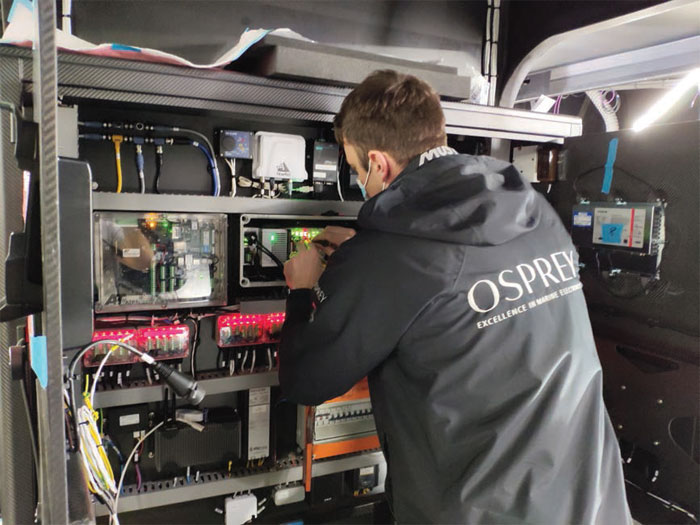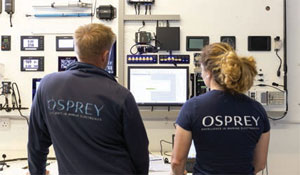

With so many diifferent electronic system aboard the modern yacht getting them to work properly together is where this new young UK company aims to deliver big practical gains
When it comes to IT, being told ‘it should be possible’ often rings alarm bells for those who’ve been there before. On the face of it the expression is optimistic, but unfortunately the reality is that it frequently means, ‘we haven’t tried it and it’s probably unlikely to work first time around.’
As the MD and founder of Osprey Technical, Rachel Oliver is all too familiar with the problems and challenges of interfacing modern electronics. Yet the company’s extensive knowledge in this area and its ability to deliver complex systems, reliable networks and unparalleled remote assistance is what has put Hamble-based Osprey Technical in demand around the world.
‘One of the things that has been making it harder for owners, builders and operators is that there is so much choice, Oliver says. ‘Even on a modest blue water cruiser you can easily end up with five different WiFi networks and an even greater number of different apps on your phone. The result is that you end up with a bunch of disparate systems which are completely unmanageable for the skipper and crew Equipment from different manufacturers may appear to use the same protocol, under the skin there can often be a range of hidden issues such as damping or the different ways in which devices might declare themselves to the network.’
Below: rigorous testing and preparation in the workshop is one of the keys to Ospreyʼs success

As boats get bigger, the complexity increases but this is a key territory for Osprey Technical where their engineering experience and close connections with the world’s leading electronic equipment manufacturers feeds into their knowledge base. And their practical approach to building systems adds another key skillset.
‘When it comes to interfacing, most of our time is spent with testing and preparation in our workshop where we build the system. And when it comes to commissioning it’s often the case that any problems will be with items that didn’t go through the test procedure in our workshop.’
However, as Oliver freely accepts, dealing with last-minute issues often goes with the territory. ‘The very nature of some of the more advanced projects is that other technical partners are developing new systems, often for the first time. The ClubSwan 125 that is one of our most recent large projects was a good example of this. The overall build time was considerable and gave us plenty of runway. But the project was also very complex so we needed to anticipate what the issues might be and have solutions in mind ahead of time’.
Future proofing on a long project like this is also very important and again much of it is about using experience and connections within the industry to create a plan that is in step with product developments and availability. However, it’s not always about the technology. According to Oliver future proofing is as much about how the boat will be operated as it is about the technology itself.
‘The way people use boats over time changes as goals shift or indeed their own experience develops. You don’t want to have to build a new system from the bottom up each time there is a change, so understanding how the boat will be used is essential for building a system that will last.’
The global pandemic has also placed additional challenges on current projects. Yet for Osprey this has also helped to bring a flagship service into the spotlight. Vessel Fusion is a remote access system that the company launched in 2019. With its ability to provide the connections to perform a wide range of diagnostic tasks remotely, the system drew a great deal of attention among those with large, complex globetrotting yachts. The benefits for a much broader audience are now becoming clear to yards as well as yacht owners and operators.
‘Vessel Fusion provides a means to connect remotely with a yacht’s electronic systems,’ says Oliver. ‘It is based on being able to connect to a Peplink platform of routers and switches which is common aboard most, if not all, modern superyachts. It means we can get right into the heart of systems and operate as if we were on board. It allows us unprecedented access, and it can also allow other technical partners to have access to their equipment. For example, the hydraulics maker Cariboni can get access to their PLC but nothing else on the network.
‘This is proving to be very appealing for yards as we take on the warranty work for the systems and can offer a fast and effective service that doesn’t involve flying people around the world.’ But perhaps most importantly, combined with a workshop that is renowned for its interfacing means that the answer to a technical query never requires the use of the word “should”.
Click here for more information on Osprey Technical »
We invite you to read on and find out for yourself why Seahorse is the most highly-rated source in the world for anyone who is serious about their racing.
To read on simply SIGN up NOW
Take advantage of our very best subscription offer or order a single copy of this issue of Seahorse.
Online at:
www.seahorse.co.uk/shop and use the code TECH20
Or for iPad simply download the Seahorse App at the iTunes store


